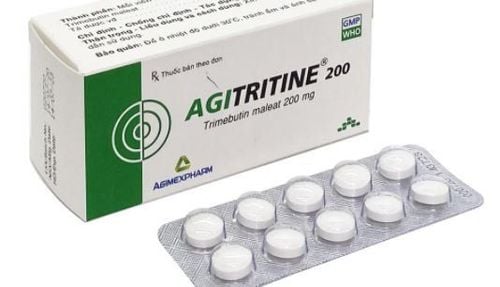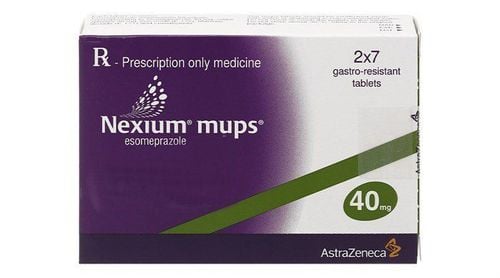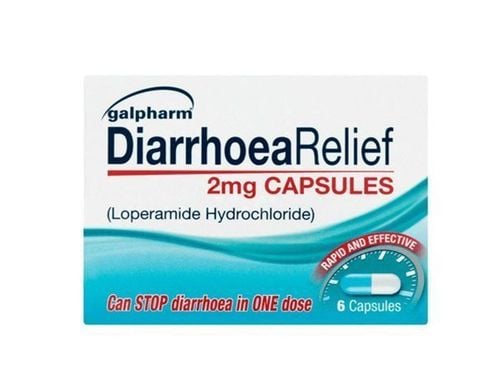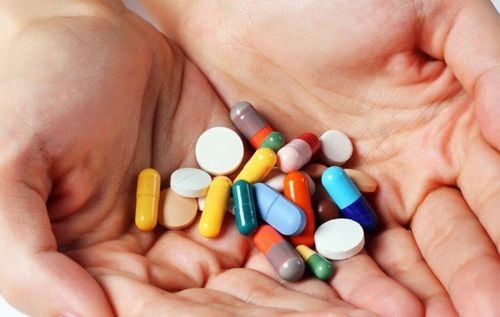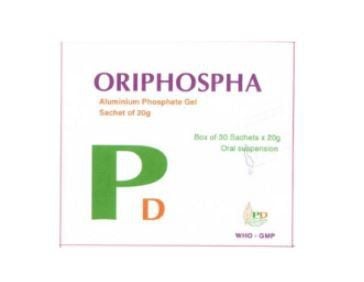This is an automatically translated article.
Raxium 20 contains the main active ingredient Rabeprazol sodium and other excipients in sufficient quantities. The drug is effective in the treatment of peptic ulcer disease, gastroesophageal reflux disease...
1. What is Raxium 20?
Raxium 20 medicine contains the main active ingredient Rabeprazol sodium in the form of Rabeprazol sodium hydrate 20mg and other excipients in sufficient quantities. This is a medicine to treat diseases of the digestive tract. The dosage form of the drug is enteric coated tablets. Packaging method is a box of 3 blisters, each blister contains 10 tablets or a box of 5 blisters, each blister contains 10 tablets
The effect of the active ingredient Rabeprazol sodium is a specific inhibitor of the proton pump H+K+ATPase, which has anti-secretory properties. stomach acid. The drug causes inhibition of both basal and stimulated gastric acid secretion. When using the drug with a therapeutic dose of 20mg, the drug quickly reaches its effect within 1 hour, the maximum effect is reached 2 to 4 hours after taking the drug. Food does not affect the bioavailability of the drug.
2. What diseases does Raxium 20 treat?
Raxium 20 is indicated for use in the following cases:
Treatment of active duodenal ulcer, active benign gastric ulcer, ulcerative or erosive gastroesophageal reflux disease (GERD) . Zollinger–Ellison syndrome and other pathological hypersecretory conditions. Maintenance therapy in gastroesophageal reflux disease and esophagitis. Symptomatic treatment of conditions such as moderate to very severe gastroesophageal reflux disease. In combination with appropriate antibacterial drugs for the eradication of Helicobacter pylori in people with peptic ulcers.
3. Usage and dosage of Raxium 20
3.1. How to use the drug: Raxium 20 is used orally. The tablet should be swallowed whole and should not be chewed or crushed. The time to take the medicine is before breakfast or before going to bed.
3.2. Dosage of the drug: For adults or the elderly
Treatment of active duodenal ulcer: Oral 10 mg or 20 mg x 1 time / day, for a period of 4 to 8 weeks. Treatment of active benign peptic ulcer: 10 mg or 20 mg once daily for 6 to 12 weeks. Treatment of ulcerative or erosive gastroesophageal reflux disease (GERD): 10 mg or 20 mg orally once daily for 4 to 8 weeks. Long-term maintenance treatment of gastroesophageal reflux disease: use a maintenance dose of 10 mg or 20 mg once daily. Symptomatic treatment of moderate to very severe gastroesophageal reflux disease: Oral 10 mg x 1 time / day for people without esophagitis. If your symptoms don't improve after 4 weeks, you should get tested. Zollinger–Ellison syndrome and other pathological hypersecretory conditions: The initial dose is 60 mg once daily. The physician may increase the therapeutic dose up to 100 mg once daily or 60 mg twice daily. Some people with Zollinger–Ellison syndrome have been treated continuously for up to a year. Treatment of Helicobacter pylori: Combination therapy for 7 days is recommended as follows: Raxium 20 x 2 times/day and antibiotic clarithromycin 500 mg x 2 times/day and antibiotic Amoxicillin 1 g x 2 times/day. For children
For children older than 12 years: Safety and efficacy in the short-term treatment of GERD (treatment duration of 8 weeks). For children under 12 years of age: Safety and effectiveness in the short-term treatment of GERD have not been established. For patients with renal and hepatic impairment: No dose adjustment is required.
Note: The above treatment dose is for reference only. The specific treatment dose depends on your health condition and the severity of the disease. For a suitable and specific dose, you need to consult your treating doctor or medical professionals.
4. In case of forgetting/overdose of medicine
In case of overdose: The maximum oral dose should not exceed 60 mg x 2 times / day or 160 mg x 1 time / day. The reason is that the drug is highly bound to plasma proteins, so it is not easy to dialyzate. Currently, there is no specific antidote, so in case of overdose, the doctor will prescribe symptomatic treatment and supportive measures.
In case of missed dose: If you miss a dose, you should try to take it as soon as possible. However, if it is almost time for your next dose, skip the missed dose and take your next dose at the scheduled time. You should be careful not to take more than double the prescribed dose.
5. Undesirable effects of the drug Raxium 20
Some side effects may be encountered when treating with Raxium 20:
Common undesirable effects, including: discharge of infection; insomnia, headache, dizziness, lightheadedness; cough, sore throat; diarrhea, nausea, flatulence, abdominal or back pain, nonspecific pain. Uncommon side effects: nervousness; bronchitis , sinusitis; indigestion, dry mouth, belching; muscle pain, leg cramps, joint pain, broken bones. Rare adverse effects such as neutropenia, thrombocytopenia, leukocytosis; Allergic reactions: Facial edema, dyspnoea, hypotension, erythema, bullous reaction; mental disorders, depression; gastritis, taste disturbance, stomatitis; interstitial nephritis. If you have any side effects during use, you need to proactively notify your treating doctor or qualified pharmacist to receive appropriate advice.
6. Raxium 20 . drug interactions
Active ingredient Rabeprazole causes inhibition of gastric acid secretion, so interactions with drugs with pH-dependent absorption may occur. Rabeprazole does not interact with liquid antacids.
Concomitant use of Raxium 20 with ketoconazole or itraconazole may reduce the concentration of antifungal drug in the blood plasma.
Active ingredient Rabeprazole inhibits the metabolism of Cyclosporin in combination therapy.
Concomitant use of Raxium 20 and warfarin increases INR and prothrombin time, which can lead to abnormal and life-threatening bleeding.
Raxium 20 should not be used concurrently with the active ingredient Atazanavir.
7. Some notes when using Raxium 20
Before treatment with the drug you need to carefully read the instructions for use and refer to the information below.
7.1. Contraindications of the drug: Raxium 20 is contraindicated in cases of hypersensitivity or hypersensitivity to any component of the drug and Benzimidazole derivatives.
7.2. Precautions for use: Improvement in signs and symptoms through treatment with Raxium 20 does not rule out the presence of gastric or esophageal cancer. Therefore, it is necessary to exclude the possibility of cancer before starting treatment. Patients with long-term treatment (especially more than one year of treatment) need regular health check-ups. Patients with severe liver dysfunction. Rabeprazole is not recommended for use in children, because there is no experience with the use of Rabeprazole in this age group. Hypomagnesaemia is rare in people treated with proton pump inhibitors (PPIs) for at least 3 months, and may be more common after 1 year of treatment. In most cases, treat hypomagnesaemia with magnesium supplementation and discontinuation of PPIs. Proton pump inhibitors (PPIs), especially if used in high therapeutic doses and for longer than 1 year, may be associated with an increased risk of osteoporosis-related fractures of the hip, wrist, or spine. , mainly in the elderly or in the presence of other risk factors. Treatment with PPIs, including the active ingredient Rabeprazole sodium, may increase the risk of gastrointestinal infections by Salmonella, Campylobacter and Clostridioides difficile. Ability to drive and use machines: Raxium 20 does not impair the ability to drive or use machines. However, if you feel drowsy while taking this medicine, you should avoid driving or operating complex machinery. Pregnancy: There are no adequate or well-controlled studies in pregnant women and post-treatment experience with commercially available drugs is limited. Raxium 20 should be used during pregnancy only when the potential benefit outweighs the possible risk to the fetus. Lactation: It is not known whether rabeprazole sodium is excreted in milk and there have been no studies in nursing women. However, according to studies, it has been shown that the active ingredient Rabeprazole sodium is excreted in the milk of rats. Therefore, Raxium 20 should not be used in nursing women. If the use of products containing the active ingredient Rabeprazole sodium is mandatory, breast-feeding should be discontinued. The above information cannot replace a doctor's advice, so when intending to use Raxium 20, patients should consult a specialist for appropriate indications.
Please dial HOTLINE for more information or register for an appointment HERE. Download MyVinmec app to make appointments faster and to manage your bookings easily.




